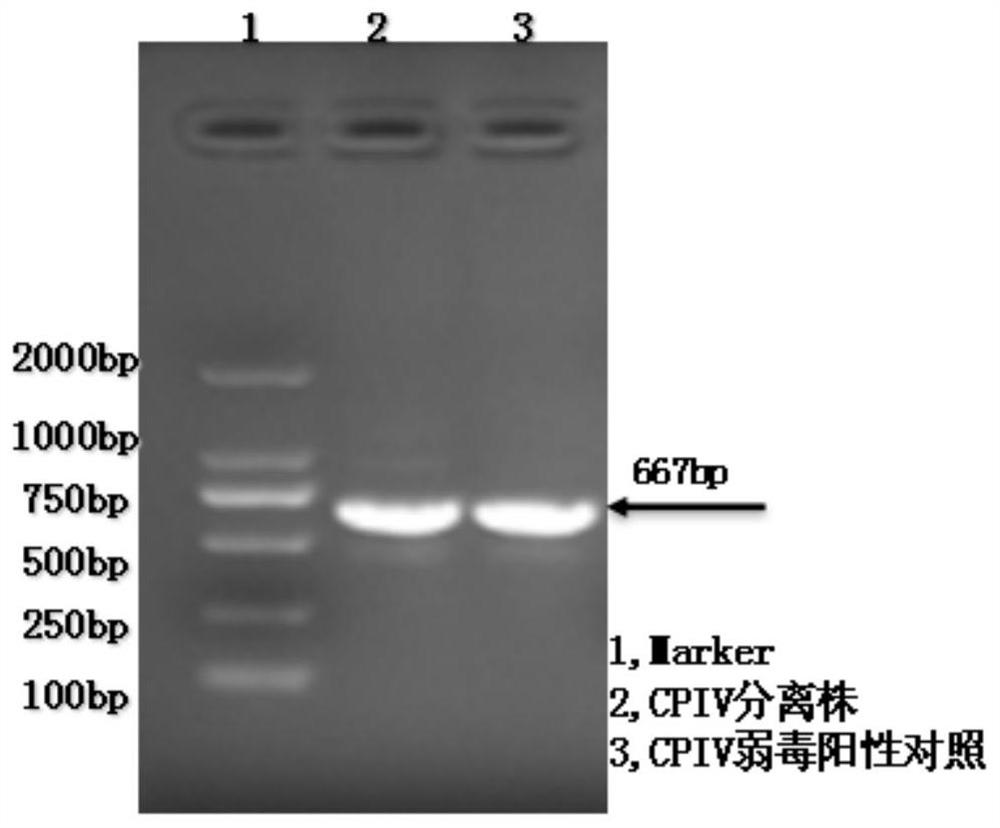Attenuated strain of canine parainfluenza virus, its application and vaccine
A technology for canine parainfluenza virus and canine parainfluenza, applied in veterinary vaccines, viruses, vaccines, etc., can solve the problems of high cost and weak pertinence, and achieve the effects of strong pertinence, low production cost and simple production process
- Summary
- Abstract
- Description
- Claims
- Application Information
AI Technical Summary
Problems solved by technology
Method used
Image
Examples
Embodiment 1
[0044] Example 1 Isolation and identification of natural attenuated CPIV / 15 strain of canine parainfluenza virus.
[0045] Materials and methods
[0046] Source of disease materials: From the pet hospital in Changchun City, Jilin Province, the puppy developed serous or mucopurulent rhinorrhea around the nostrils, accompanied by clinical symptoms such as mild cough, and was initially diagnosed as suspected canine parainfluenza virus disease. A total of five nasal secretion disease materials (numbered as No. 1, No. 2, No. 3, No. 4, No. 5) were collected, and their nasal secretions were added to 3 times PBS buffer (pH) containing penicillin and streptomycin. 7.2) After repeated freezing and thawing 3 times, centrifuge at 8000r / min at 4°C for 15min, filter and sterilize with a sterile filter (0.22μm), and store at -30°C after negative bacterial test.
[0047] Cells: Vero (F87) cell line was purchased from China Veterinary and Veterinary Drugs Supervision Institute, and kept and s...
Embodiment 2
[0058] Example 2 Comprehensive identification of canine parainfluenza attenuated strain CPIV / 15
[0059] Identification of viral nucleic acid types: 5-Iododeoxyuridine (5-IUDR) method: Vero cells were cultured in a 96-well plate, and after the cells grew into a monolayer, the growth medium was poured out and replaced with 2% fetal bovine serum DMEM maintenance solution, and 5-IUDR was added to the maintenance solution to make the final concentration 50 μg / mL, then inoculated with different dilutions of virus solution in the cell culture wells, each dilution was repeated 4 times, and observed daily after inoculation cytopathic. The TCID of the virus grown on Vero cells was determined by taking the negative logarithm of the highest dilution at which the virus appeared CPE as the virus titer 50 Changes, while the culture medium without 5-IUDR was used as a control. Because 5-IUDR has obvious inhibitory effect on DNA virus, it has no or only low inhibitory effect on RNA virus, a...
Embodiment 3
[0092] Example 3 Canine Passaging Reversion Test
[0093] Test materials and methods:
[0094] Cells: African green monkey kidney passage cells (Vero), purchased from China Veterinary Drug Administration, and preserved by Beijing Shengtaier Technology Co., Ltd.
[0095] Virus species: Canine parainfluenza virus attenuated CPIV / 15 strains, F50 generation; preserved and provided by Beijing Shengtaier Technology Co., Ltd.
[0096] Experimental animals: The experimental dogs were 42- to 49-day-old healthy beagle dogs with CPIV antibody SN negative or ≤ 2 who had not been immunized with canine parainfluenza virus vaccine.
[0097] Cell passage stability test: use Vero passage cells, adopt the method of simultaneous inoculation, 37 ℃ 5% CO 2 Cultivated under the condition of culture, more than 80% cytopathic effect (CPE) occurred in 5 to 7 days, harvested, and then continued to use Vero culture to subculture to 60 generations (CPIV / 15F60) to observe the changes of cells in each ge...
PUM
| Property | Measurement | Unit |
|---|---|---|
| diameter | aaaaa | aaaaa |
Abstract
Description
Claims
Application Information
 Login to View More
Login to View More - R&D
- Intellectual Property
- Life Sciences
- Materials
- Tech Scout
- Unparalleled Data Quality
- Higher Quality Content
- 60% Fewer Hallucinations
Browse by: Latest US Patents, China's latest patents, Technical Efficacy Thesaurus, Application Domain, Technology Topic, Popular Technical Reports.
© 2025 PatSnap. All rights reserved.Legal|Privacy policy|Modern Slavery Act Transparency Statement|Sitemap|About US| Contact US: help@patsnap.com



